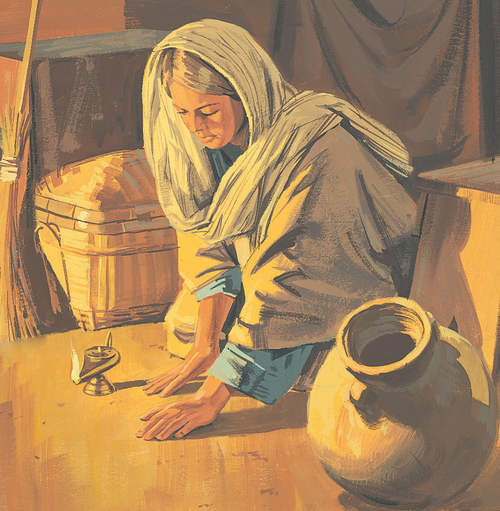In the contemporary era, individuals grapple with existential questions and seek clarity within a multifaceted world. The Bahá’í teachings espouse principles of unity, love, and divine guidance, urging humanity toward collective progression. Among the various modes of articulation present in Bahá’í scripture, parables serve as profound pedagogical devices, encapsulating complex spiritual truths within accessible narratives. This treatise delves into the parable of the lost coin, a poignant analogy that elucidates the transformative potentials inherent in the human experience, particularly in the context of concepts surrounding a ‘Second Life’.
The parable of the lost coin, nestled within biblical narratives, stands as a resonant metaphor for the journey of self-discovery and redemption. It describes a woman’s fervent quest to recover a solitary coin, symbolizing not only material value but also the intrinsic worth of every individual in the eyes of the Divine. It is crucial to recognize that this tale transcends mere moral instruction; it invites individuals to reconsider the dimensions of their own lives. How often do we overlook the significance of our own spiritual essence, excusing the mundane distractions that plague our daily existence?
In the Bahá’í framework, every soul is regarded as a priceless gem, equally infused with divine purpose and potentiality. The loss of the coin encompasses the broader theme of spiritual disconnection that many experience in their pursuit of material satisfaction. This emphasis on intrinsic value urges a reorientation of focus. The ‘Second Life’ premise, therefore, emerges as an invitation to awaken to a reality where spiritual engagement and quest for the divine supersede trivial pursuits.
The journey toward enlightenment is not a solitary endeavor. Community lies at the heart of Bahá’í teachings; human beings thrive within inclusive environments that nurture growth and facilitate connection. The woman’s persistence in recovering her coin can be likened to the collective journey of humanity in striving for unity, love, and purpose. In this pursuit, the parable suggests that when one member of a community rises to reclaim their sense of value, the ripples of that action extend outward, inspiring others to embark on their own transformative journeys.
Moreover, the parable underscores the necessity of introspection and self-evaluation. The idea of Second Life may refer to the dawning awareness of one’s spiritual identity, highlighting a transition from a superficial existence to one characterized by depth and intentionality. This reawakening often necessitates shedding deeply ingrained societal expectations and the resultant confusion. The lost coin exemplifies the personal battles individuals encounter in reclaiming their spiritual essence amidst external distractions and false identities.
As we ponder upon the implications of the Second Life, it becomes indispensable to interrogate our values and aspirations. Contemporary society often propounds the allure of material gain, prioritizing accumulation over understanding. However, Bahá’í teachings challenge this narrative, boldly asserting that true fulfillment emanates from a harmonious equilibrium between the material and spiritual realms. The search for the lost coin thus serves as a microcosm of the broader human experience—an affirmation that true treasure lies not in possessions, but in the cultivation of spiritual virtues and meaningful connections.
In this new era, the notion of unity—even within diversity—commands significant attention. The lost coin is but one fragment in a vast tapestry of humanity; its recovery is a metaphor for the holistic healing that occurs when individuals recognize their shared heritage and the collective responsibility to uplift one another. The Bahá’í teachings extol the virtues of altruism and service, encouraging adherents to pursue pathways of action that elevate not just oneself, but the entire community.
A critical examination of the parable also reveals the transformative power of forgiveness and compassion. The woman’s search can symbolize the unconditional love of the Divine—forever seeking to retrieve each lost soul. The Second Life necessitates embracing a renewed understanding of forgiveness, both towards oneself and others. The act of reclaiming what was lost fosters an environment conducive to healing, and ultimately, a deeper comprehension of divine mercy.
In contemplating the Second Life, individuals may also grapple with the existential aspects of identity. The quest for the lost coin beckons one to re-evaluate who they are beyond societal labels. It calls for a renaissance of self-awareness, encouraging individuals to delve deeper into their authentic selves—those unblemished by external validation. The transformative potential of this exploration aligns directly with the overarching Bahá’í tenets that advocate for self-discovery through spiritual exercises and community engagement.
In summation, the parable of the lost coin in the context of Bahá’í teachings profoundly illustrates the philosophical and spiritual underpinnings of the Second Life. It emphasizes the countless opportunities for self-discovery, redemption, and community upliftment available to humanity. Within this narrative lies an invitation to transcend the superficiality that often defines existence, allowing individuals to seek genuine fulfillment grounded in unity, love, and a pronounced understanding of one’s spiritual essence. As we navigate the complexities of the modern world, the lessons embodied in this parable remain timeless, beckoning each soul to embrace the transformative journey toward a redefined existence—one that embodies the essence of the lost coin found.
